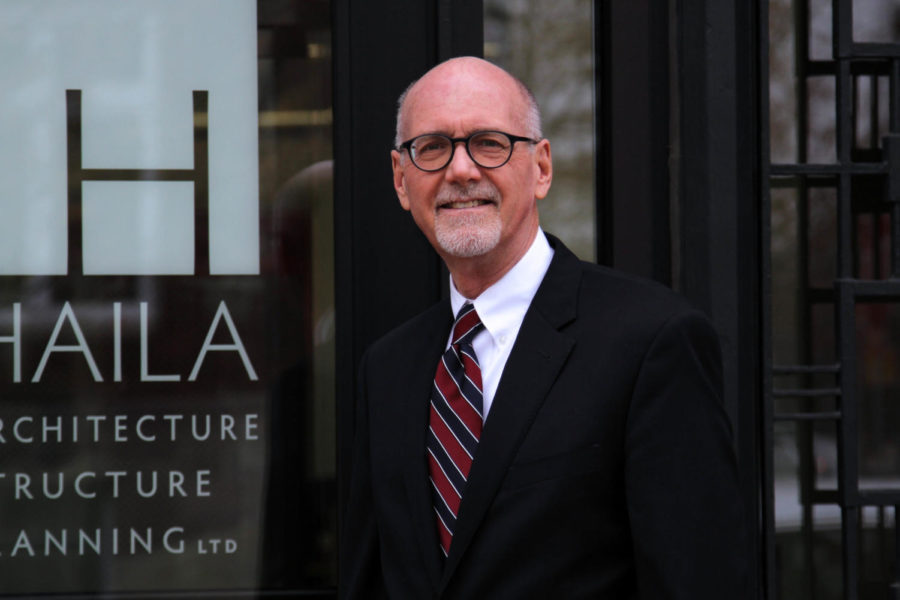Three sides to international students and Ames’ economy
Mayor-elect John Haila poses in front of Haila Architecture Firm on Nov. 14. Haila is the first mayor-elect in Ames since 2006.
February 6, 2018
International students are a driving factor in the Ames economy. Here are three different perspectives on their impact.
The mayor speaks
A total of 4,115 international students were enrolled at Iowa State in fall 2017, comprising a little over 11 percent of the total enrollment, according to the Iowa State’s Office of the Registrar. Over 6 percent of the population of Ames is international students.
“International students are more likely to be here 12 months out of the year versus other students who are from Iowa or the United States, they will be here for about nine months,” Ames Mayor John Haila said.
Haila said certain retailers and enterprises could determine their companies’ next location based on the population of a city.
“I heard they have a matrix to analyze potential customer numbers,” Haila said. “When you get to a certain level, they are interested in coming to your city, because there’s enough traffic.”
More international students and residents in general also increases community funds from sales tax.
“The sales tax in Ames is 7 percent. One penny of that was voted on by the residents quite a while ago,” Haila said. “40 percent of the money generated by that goes to fund human services groups, make improvements to parks and other community betterment programs. So, the more residents, the more sales tax.”
Haila said he is starting to develop focus groups and ask people from different nationalities to serve on boards and commissions of Ames. Some of the board members have a one-year term, which is designed for students.
The only requirement for an international student to serve on the boards and commissions is to be a resident of Ames. All the information can be found on the city of Ames’ website, under Boards & Commissions.
Haila said he wants to hear the voices of international students and understand their needs.
“We are thrilled that the international students and their families are here,” Haila said. “If we can provide any additional service, we would love to do that.”
There are several ways to get in touch with the city government. Students can go to the city of Ames website and find the email address for the mayor and all council members. They can also write an actual letter to the city government.
They can even go to City Hall and talk to government workers about their needs and suggestions.
“We are a mini melting pot here. I heard one time we had over 100 different countries represented in the university alone,” Haila said. “I think Ames is committed to find more ways to make people from all over the world feel welcome and valued.”
For new international students and their family members, the Ames Convention & Visitors Bureau has an informative website on where to eat, stay and shop in Ames. It also has a calendar of events for visitors and residents.
The science behind it
David A. Swenson, associate scientist in the department of economics, explained how the international students helped Ames’ economic growth.
“The way we think about economy is it grows if you can bring the money in from the outside of the economy,” said Swenson. “So, Ames’ economy has been able to attract more international students to go to the university; we treat that as an export sale. We are selling education to somebody who otherwise wouldn’t have come to Ames.”
All international students at Iowa State add size to the Ames’ economy simply because they spend money in Ames, which often times come from outside the local economy.
“The money is coming into our economy, and is being spent in our economy. As a consequence, it has a multiplier effect, it’s not just that they buy housing, cars, groceries and personal items, but to provide those goods and services we have to have jobs,” said Swenson. “So [student’s] spending supports jobs in the regional economy. For every million dollars that is spent by students, it supports $330,000 worth of wages and salary income.”
According to Swenson, Ames became a metropolitan city in 2000, when its core population reached 50,000 or more. Once a city is categorized as a metropolitan city, it will be eligible for different categories of federal funding.
Student perspective
Yingqi Huang, senior in psychology, is a Chinese international student, and all her tuition and daily expenses are paid by her parents. They wire the money from China to her American bank account at the beginning of every semester.
“My tuition for each semester is about $10,000; I spend nearly $900 every month for food and groceries; my rent is $705 per month; all other leisure activities and non-essential purchases will cost me about $100 per month,” said Huang. “Among all international students I’ve encountered, I consider myself pretty good at spending money wisely. ”
Huang had no idea that Ames is offering a position for international students to serve on boards and commissions. She also wasn’t aware of all the hosting websites for visitors and guests of Ames.
“I think most of Iowa State’s international students are just here to go to college. They don’t pay a lot of attention to Ames’ city life,” said Huang. “Maybe Ames’ government can think of a way to inform more international students about their plans or activities.”
Huang also commented on a lack of entertainment venues in Ames. She believed that adding more shopping and amenities would attract more students and boost the economy.
















